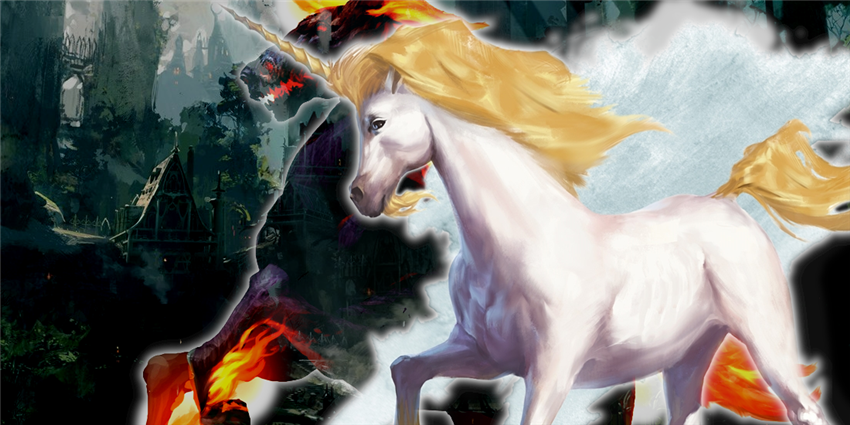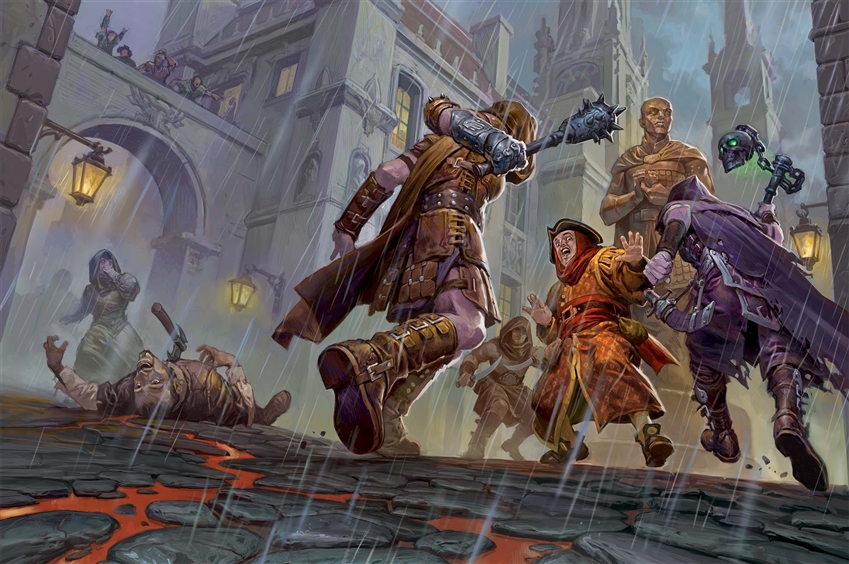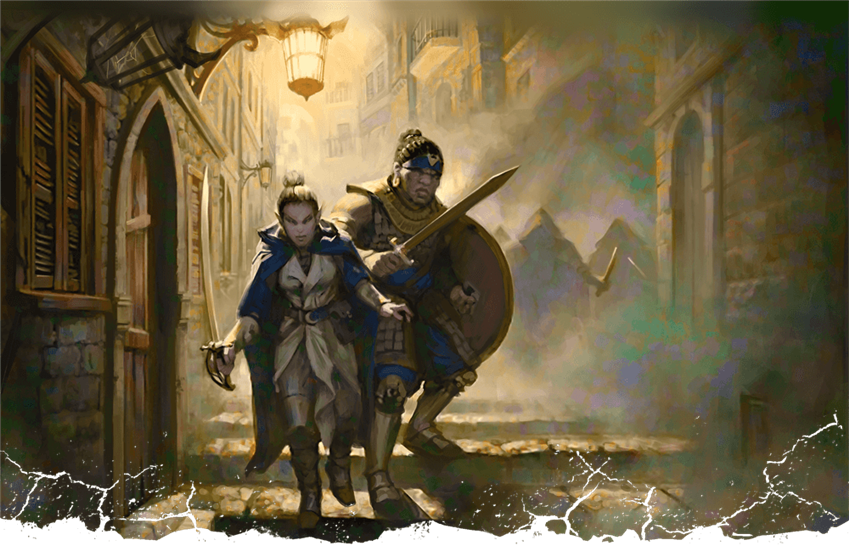Take a second to think about some of the most memorable chase scenes in cinema.
Hardboiled cop Popeye Doyle in The French Connection, weaving in and out of traffic in a madcap race to catch a train. James Bond, climbing a construction site in Casino Royale as his prey makes death-defying leaps across scaffolding. Indy and his friends in Indiana Jones and the Temple of Doom, piloting a mine cart as they flee from Thuggee pursuers.
Chase scenes remain in a viewer’s head forever. And with some planning, any Dungeon Master can create the same nail-biting moments in a game of Dungeons & Dragons, delivering just as many thrills as a combat encounter when done well.

The Rules of the Chase
Chase rules are located in Chapter 8 of the Dungeon Master’s Guide. Here are the most important points:
- Chases require a quarry and at least one pursuer, and in some instances, the pursuer can become the quarry. (For instance, if you’re running after a thief in a market and guards suddenly arrive, assume you’re the thief, and run after YOU instead.)
- The quarry should start the chase some distance ahead of the pursuer.
- Once that distance is determined, have all parties roll for initiative, but keep in mind that players are only allowed one action and one move. Bonus actions and reactions are not permitted, likely to streamline the chase and keep classes with high movement capabilities from catching the quarry too soon.
- Chase participants can freely use the Dash action 3 times plus their Constitution modifier. For every usage of Dash afterward, they must pass a DC 10 Constitution check or gain a level of exhaustion. Once they hit exhaustion level 5 and their speed drops to 0, they fall out of the chase.
- Every chase participant rolls a d20 at the end of their turn to see if complications occur. Complications are the bread and butter of D&D chases, and the Dungeon Master’s Guide presents two tables to consult from - Urban Chase Complications and Wilderness Chase Complications. More on those later, but one vital tidbit to remember: Complications affect the NEXT creature in the initiative order, not the one who just made their roll!
- Chases can end in a few ways: 1) When the quarry or pursuer drop from exhaustion, 2) When the pursuer catches up to the quarry, perhaps initiating normal combat rules, 3) When the quarry succeeds on a Dexterity (Stealth) check at the end of a round to hide (assuming they’ve escaped the pursuer’s sight), and my favorite, 4) When you, the DM, decide to call it!
Keeping these rules in mind, one thing is clear - a chase should be treated as a deliberate activity - a D&D mini-game - and there needs to be a clear delineation on the DM’s part to state: “Okay, now we’re in a chase scene. Your main goal is not to incapacitate this opponent, but to catch them.”

The Design of the Chase
Because chase rules are quite separate from normal D&D gameplay, I’ve found it best to only use them for critical story moments when you, as a DM, absolutely know that a chase is going to occur. Sure, you could also utilize them during a random battle when your players want to nab that fleeing bugbear, but I prefer my chases to be bold set pieces - for instance, a dash across the castle’s parapets in order to catch the assassin who’s poisoned the king!
Once the story impetus has been decided, consider whether you’ll run the chase as a Theater of the Mind exercise or on a tactical grid. Theater of the Mind may be easier since chases cover large distances and battle maps tend to make players think in terms of D&D’s normal movement rules, which are intended for small skirmishes where one square generally equals five feet. Or, if you’re playing virtually, using D&D Beyond’s shared dice rolling feature can keep everyone involved in watching the tension unfold.
Next, determine if your chase is an on-foot affair or if other forms of transportation will be involved. The rules assume that chase participants will be running, but you could put everyone on warhorses or even elephants simply by looking up the stat blocks on D&D Beyond. You could even use the stats of these mounts to represent vehicles that don’t have readily available stat blocks, which is a handy DM hack I’ve often used in the past.
Finally, when you’re running the chase itself, judiciously throw unpredictable hurdles at both the pursuers and the quarry at the end of each turn. The Chase Complications tables in the Dungeon Master’s Guide offer up great examples, like a stained glass window players have to jump through in an urban chase, or a swarm of insects that might collide with the party during a wilderness chase. I’d recommend tweaking these tables as appropriate for your campaign, since they barely scratch the surface of possibilities in more varied settings - for instance, snowy mountaintops. (Imagine a squad of feverish Chardlyn Berserkers chasing the heroes across an icy bridge in Icewind Dale: Rime of the Frostmaiden!)
Be aware that both tables in the Dungeon Master’s Guide state that d20 rolls of 11-20 lead to no complication. If you’d rather have no lulls in the action, try creating your own complications for these rolls. For example, in my Ghosts of Saltmarsh game, I had rolls from 11-15 result in chase participants crashing into important NPCs. One of my players rolled a 13, barrelled through the window of a Saltmarsh public bathroom, and came face to face with Oceanus, the sea elf she’d rescued ages ago from pirates. A hilarious moment was had by all - and then Oceanus joined the pursuit!
Lastly, chases are an incredible opportunity to flex your DM narration skills. A pursuer doesn’t just jump through that stained glass window - they catapult themselves into it like Batman, dozens of shards ripping their cloak as they somersault forward, barely getting up in time to catch a glimpse of their quarry’s feet darting down an alleyway to their right. That insect swarm doesn’t just make an attack of opportunity on the prey running past it - they lash out with their stingers in a dissonant symphony of frenzied buzzing. Amp up the colorful language, aim to recreate a film feel, and watch as the chase ends up leaving a deep impression on your players, just like the opening of Casino Royale.

The Thrill of the Chase
For a good chase template, look no further than Chapter 4 of Waterdeep: Dragon Heist, which features both street and rooftop chases. Personally, I’ll never forget the moment in this campaign when my rogue parkoured across Waterdeep’s chimneys trying to catch three-spined devils. The player before me rolled a 7 on the scene’s Rooftop Chase Complications table, and my DM said that the flagpole of Waterdeep’s Kara-Tur embassy was coming my way, threatening to slow me down.
Luckily, I made my DC 15 Dexterity saving throw - rolled a natural 20, in fact - and swung around the flagpole three times, cartwheeling into the air and nimbly joining my comrade as we lashed a flurry of daggers out at our foes.
That moment, I really felt the thrill of the chase - and the movie in my head was just as good as any I’d seen on screen.
Add some wild chases to your crazy mysteries and preorder Candlekeep Mysteries!
Jeremy Blum (@PixelGrotto) is a journalist, gaming blogger, comic book aficionado and fan of all forms of storytelling who rolled his first polyhedral dice while living in Hong Kong in 2017. Since then, he's never looked back, and loves roleplaying games for the chance to tell the tales that have been swirling in his head since childhood.








-
View User Profile
-
Send Message
Posted Feb 23, 2021Fair question. The tables in the DMG are indeed lacking in this regard, and while I didn't think of it at the time of writing this piece (and was up against my word count), placing more decision points in a chase is a good call. One way to do it, off the top of my head, is to have multiple quarries and split the route towards them in multiple ways. Let's say some players pursue through the streets while the more acrobatics-orientated ones take a higher path. I'd probably create different Complications tables for each route and throw in ways that the PCs on each path can narrow the chase or affect the other path - ie, maybe the rogue on the rooftops runs into a construction crane carrying lumber; her complication could be choosing to dash around it (and maybe catch up with her quarry) or risk severing the rope holding the lumber, which would potentially cause her to lose her prey but also might trap the quarry her party members are chasing on the route below her. Right there you have a decision point, not to mention the effects from the collateral damage of the rogue dropping a load of lumber into a street.
I think narration and decision points can go hand to hand in this manner, though it does require some homebrewing on the DM's part. I'll keep this in mind for future articles.
-
View User Profile
-
Send Message
Posted Feb 23, 2021You phrased it much better than I did :D
Thanks Jeremy and zeromh for following up and expanding on my rant.
-
View User Profile
-
Send Message
Posted Feb 23, 2021I like that!
I also think it's possible to use obstacles similar to those in the DMG, but make them better decision points by not setting in stone the potential solutions ahead of time. For example, a crowd is blocking the way. Just ask the player how they want to handle it. A PC with a strong presence could command the crowd to move (which would help everyone in the party). An acrobatic PC could leap from barrel to barrel over the heads of the throng. Magic users have numerous spells that might help. There's no reason to say "you have to make roll X or roll Y and that's all you can do."
Thanks for the response.
-
View User Profile
-
Send Message
Posted Feb 23, 2021Thanks, got something for myself there! Will try to add chaise next session
-
View User Profile
-
Send Message
Posted Feb 24, 2021This homebrew variation on chases has been working nicely for me over a theatre-of-mind VTT campaign.
https://dumpstatadventures.com/the-gm-is-always-right/homebrew-abstracted-chases?rq=Chase
-
View User Profile
-
Send Message
Posted Feb 24, 2021I had to run a chase completely unprepared a few sessions ago, had no idea the party would run from danger. Since I wasn't clued up on chase rules in the DMG, I scanned through them, and then gave up and ran a simple skill challenge based on death saving throws (get 3 successes to escape before 3 failures when you're captured). It was fun having the players quickly describe which skill they were using and what they were looking for and I've since refined the rules a little in case I ever need something similar.
Having said all that, I also wouldn't mind looking at the actual DMG rules for chases and figuring out how it goes and actually using them to see which I like best.
-
View User Profile
-
Send Message
Posted Feb 25, 2021I am glad we are getting more articles. I hope we get some more class guide ones and how to role play monsters ones.
-
View User Profile
-
Send Message
Posted Feb 26, 2021This is a great article! Thanks for sharing
-
View User Profile
-
Send Message
Posted Feb 27, 2021“Build better encounters by clarifying to myself what are the stakes of the encounter, how am I going to raise the tension, how to cut it short when becomes boring because there are no questions to answer left.”
This is gold! Thank you.
i especially like how you think of encounters almost as a scene with a dramatic question. Once that question/conflict is resolved, you wrap up quickly and transition — which is GREAT for pacing.
-
View User Profile
-
Send Message
Posted Mar 1, 2021I think it’s more along the lines of the difference between combat and chases are that combat is a localized event whereas a chase is adding numerous more elements to the game such as obstacles or traps or even exhausting yourself. A monk would know that if they ran too hard for too long, they would be tired before catching the quarry. That’s where the con saves come in to fight exhaustion, because if they use their action AND bonus action to dash, well even Usain Bolt would be tired after a few dashes. I think the 30ft movement is a normal run/fast jog and a dash is a short sprint. Nobody can sprint for too long of a duration or they’ll burn out.
-
View User Profile
-
Send Message
Posted Mar 1, 2021And that's good! Chases are incredibly boring. The faster they're finished the better for the progression of the session. I hate them with a passion to the point I start casting killing spells when forced into one, forcing the dm to or kill my character or stop abusing the mechanism.
-
View User Profile
-
Send Message
Posted Mar 1, 2021I totally agree.
-
View User Profile
-
Send Message
Posted Mar 2, 2021Def using this my next campaign.
-
View User Profile
-
Send Message
Posted Mar 2, 2021The movie speed set in D&D anyone? Could be a good fit in an Eberron setting :)
-
View User Profile
-
Send Message
Posted Mar 5, 2021*cries in Aarakocra*
-
View User Profile
-
Send Message
Posted Mar 11, 2021yes pls stay
-
View User Profile
-
Send Message
Posted Mar 11, 202130' movement over 6 seconds is more like power walking. It's not very fast at all, though a character laden with armor, weapons and a backpack full of stuff will realistically go this fast to not tire him/herself.
A real-life horse gallops at around 25-30 mph. If you convert that to feet per 6 seconds, that's about 220'. Assuming that's a dash, a real riding horse should either have a speed of 110' or it should have a feature that doubles its base movement speed while dashing.
-
View User Profile
-
Send Message
Posted Mar 15, 2021I am trying to make a chase scene with a horde of MAnnequins for more of an epic/horrifying moment, would you recommend that I left this in my Highway to Hell Campaign?
-
View User Profile
-
Send Message
Posted Mar 15, 2021Are we talking your PCs are moving through some long forgotten ruins and stumbling they suddenly notice something waking up.
Make it appear like corpses twitching and suddenly reanimating their limbs twisting grotesquely in ways that cannot be humanely possible but slowly they begin to pick up speed as the PCs eyes defy their senses these creatures start multiplying as the debris they thought was the floor begins to give way.
Revealing what they're walking on is the amassed gathering of these creatures and with every moment more and more are waking up as more and more of the ground around them is collapsing into the darkness as the creatures once prone beneath them are clambering up to where they were...
Its only a matter of time before they realize what woke them up are now at the bottom of the pile and they turn their attentions downwards once and pick up speed as the once large pile tumble down towards them what light is slowly being blotted out by their numbers.
It might be worth running IF you still had the time...
-
View User Profile
-
Send Message
Posted Mar 15, 2021The PC's are going to be walking through a sort of castle hospital thing. They sort of discover them in a pitch black room. I already have their introduction set up and everything.